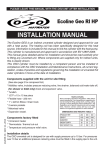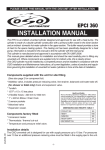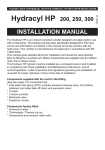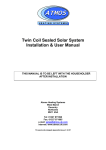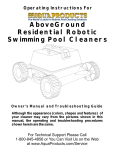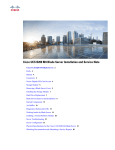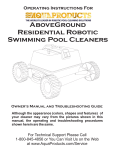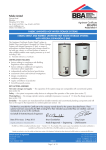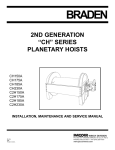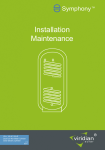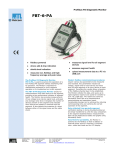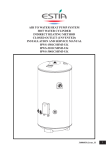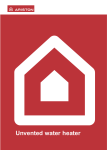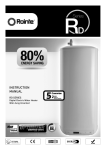Download INSTALLATION MANUAL SOLARCYL
Transcript
PLEASE LEAVE THIS MANUAL WITH THE OSO UNIT AFTER INSTALLATION SOLARCYL IM/SC2 INSTALLATION MANUAL This cylinder is manufactured and approved in accordance with EN 12897:2006. This manual gives detailed advice for installation and should be read carefully prior to fitting any unvented unit. This OSO cylinder must be installed by a competent person and be installed in compliance with the OSO Installation and Maintenance Instructions, all current legislation, codes of practice and regulations governing the installation of unvented hot water cylinders in force at the date of installation. Components supplied with the unit for site fitting (See also page 2 for component list) * Multibloc valve, includes pressure reducing valve, line strainer, balanced cold water take off, (for shower or bidet only) check and expansion valve. * Tundish Health and Safety * 1/2’’F x 15 x 15 tee piece Manual Handling Operations Regulations 1992 defines manual handling as: “any transporting or supporting of a * Flexible hose load (including the lifting, putting down, pushing, pulling, carrying or moving thereof) by hand or bodily force”. The * 3/4’’ x 22mm Elbow / Drain Cock Regulations set no specific requirements such as weight limits. However common sense still has to be used * Blanking plug based on an ergonomic approach for each individual. * Motorised valve (indirect only) DIMENSIONS AND WEIGHTS TABLE 1 * Expansion vessel. PRODUCT REF. 197250300380 HEIGHT 1150140016002090 DIAMETER 580580580580 WEIGHT EMPTY 50545783 MAX WEIGHT FULL 241 297 339 454 COIL SURFACE AREA - M² UPPER COIL 0,40,40,40,8 LOWER COIL 0,80,80,80,8 Components factory fitted * Immersion heater(s) * Thermostats / thermal cut-out * Temperature and pressure relief valve. 142044-05 Installation details The OSO unvented unit is designed for use with supply pressure up to 16 bar. For pressures over 16 bar an additional pressure reducing valve must be fitted in the supply pipe to the unit. -1- General Layout Fig: 1 SOLARCYL TWIN COIL Twin Coil Single Immersion Heater KEY 1 1A 2 2A 3 4 5 6 7 7A 7B 7C 8 Return 3/4” BSP Boiler Return 3/4” BSO Solar Flow 3/4” BSP Boiler Flow 3/4” BSP Solar Pressure Reducing Valve Multibloc Includes Item 4 Expansion valve Temperature and Pressure Relief Valve Tundish Immersion Heater Immersion Heater Thermostat Thermostat Boiler Thermostat Solar Cold Feed Tube (Not supplied see Table 2) SOLARCYL SINGLE COIL Single Coil Twin Immersion Heater Part No. CUTAWAY KEY 355013 (3.0 bar cartridge REDC 355013) 510505 550853 219002 71259 80020 80030 80020 Part No. 9 10 11 13 14 15 16 17 18 19 20 21 Hot Water Outlet 3/4” BSP Flexible Hose Flexible Hose for Expansion Vessel Elbow / Drain Cock Cable Entry Electrical Box Tee Piece Discharge Pipe (Not supplied) Motorized Valve (Not Factory Fitted) Sensor pockets ø 8 mm T-piece for expansion vessel conn. Expansion vessel Size Lenght of tube (ø22) mm Exp. vessel pre charge 197 860 2,5 bar 250 1060 2,5 bar 300 1300 2,5 bar 380 1775 2,5 bar 202108 91911 250445 250006 92000 AX12, 19 or 24 TABLE 2 -2- COLD WATER SUPPLY 1. To obtain the best performance from your OSO unvented system it is advisable to feed the unit with an uninterrupted supply. 2. Before connecting to the multibloc, flush the cold supply pipework of all flux and debris. 3. Locate the water heater in a suitable position to facilitate the installation of the cold water supply, discharge fittings and pipework. Also take into account access to the immersion heaters and the commissioning valve. 4. Fit the combined male elbow drain cock to cold supply point (13), so that the compression fitting is vertical. 5. Fit the blanking plug (12) to the secondary return fitting. If secondary return is to be used - see point 16. 6. Fit the female outlet of the tee piece to the temperature and pressure relief valve (5) with the horizontal connection facing right at approx. 45°. 7. Fit the tundish (6) to the tee piece using a short length of 15mm copper tube. 8. Fit the length of copper tube 22mm specified in Table 2 to the cold feed elbow (see 4 above) to include a T piece (20) for expansion vessel flexible hose. 9. Fit the pressure reducing valve (3) to the top of the copper tube (see 8 above), so that the black knob is facing right. 10.Connect the flexible hose to the 1/2’’ outlet of the expansion valve (4) and the horizontal outlet of the tee piece (see 6 above). Discard compression nut & ring. 11.If a balanced mains pressure cold water supply is required to a shower or bidet (over rim type only), remove the blanking cap from the pressure reducing valve (3) and connect to the shower or bidet cold supply. Using the balanced cold connection to feed bath taps can reduce the flow available to the unvented cylinder. (Major shower manufacturers advise fitting a mini expansion vessel in the pipework to accommodate thermal expansion and prevent tightening of shower controls) 12.Connect the cold supply to the Multibloc (3). 13.Fit the expansion vessel to the wall close to the water heater using the enclosed mounting bracket. Connect the expansion vessel hose to the T piece in the cold feed pipe to the cylinder. The expansion vessel is supplied with the OSO unit, fit as shown on page 2. Hot water supply 14.Connect the hot water supply pipe to the outlet (9). Ensure connection is water tight. Secondary return (optional) 15.Connect secondary return if required to fitting according to diagram on page 16. Discharge pipe 16. Connect the discharge pipe from the tundish (6). This must have a continuous fall and be fitted in accordance with The Building Regulations (see page 16). The tundish should be installed away from electrical devices. Boiler Primaries - Primary flow & return and motorised valve 17.The boiler primary flow and return connections should be made to the upper coil connections unit. The motorized valve can be connected to either the primary flow or return pipe. The primary flow and return fittings are 3/4’’ BSP female. The valve has 22mm x copper connections. The direction of primary flow in the boiler coil is bottom to top. The maximum operating temperature of the primary flow would typically be 82°C. 18.For electrical connection of the motorised valve and immersion heater, please read Electrical Installation Instructions. (Pages 7 - 11) Solar Primaries 19.The Solar flow and return connections should be made to the lower coil connections. Temperature control from the Solar circuit is achieved using a differential solar controller. This controller must be wired in series through the thermal cut-out on the OSO thermostat (see figure 4 pages 9 & 11). If Solar Collectors are to be installed at a later date then connect the boiler primaries to the lower coil. The driection of solar primary flow in the solar coil is top to bottom. 20.The solar circuit must be installed with a solar hydraulic station which must incorporate a pump and non-return valves in both flow and return within the solar circuit. This system will prevent thermal siphoning when the pump is not active. -3- 21.Temperature sensors for the cylinder provided with the differential controller should be inserted into the pockets provided (see pt 5 above). 22.There is no maximum primary temperature from the solar system and primary temperatures in excess of 100°C are not unusual. All components on the solar circuit must be suitable for these higher temperatures. Should the solar circuit be installed incorrectly, then all approvals and guarantees of the cylinder are invalid. COMMISSIONING Filling up 1. Open a hot tap. 2. Open the cold water supply valve 3. when water flows from hot tap, close the tap 4. Allow the system to stabilize for 5 minutes 5. Open each hot water tap in turn to expel air from the system pipe work. 6. Check for leaks. 7. Manually operate Temperature and Pressure Relief Valve (5) to ensure free water flow through discharge pipe. (Turn knob to left.) Draining/flushing 1. Turn off mains supply. 2. Connect hose pipe to drain cock at base of cylinder. 3. Open hot tap. Open drain valve and open temperature & pressure relief valve. 4. Allow to drain. Follow commissioning instructions (above) to refill. SAFETY AND MAINTENANCE Safety Cut-out 1. The safety cut-out operates if: a. Wiring is incorrect. b. The immersion heater thermostat or cylinder thermostat fails. c. Thermostat is set too high. 2. Remember before resetting the safety cut-out or altering the thermostat setting, isolate electrical supply to the unit prior to removal of the electrical box lid. 3. Reduce thermostat setting and press the reset button. After adjustments are completed, ensure the lid to the electrical box is replaced correctly and the retaining screw is fitted. 4. If still out of operation, contact installer. RECOMMISSIONING INSTRUCTIONS Cold or tepid water discharge from tundish - The tundish should be installed away from electrical devices. 1. Close cold water supply valve 2. Open a hot tap. 3. Repressurise the expansion vessel air charge to its set level. 4. Close hot tap 5. Open the cold water supply valve Hot water discharge from tundish This indicates a malfunction of a thermal cut-out, operating thermostat or the combined temperature and pressure relief valve. Turn off the electrical supply to the immersion heater and also isolate an indirect unit from the boiler. Contact the installer or competent engineer. TABLE 3 Size Max. design litres pressure 197 8 bar 250 8 bar 300 8 bar 380 8 bar Operating pressure Pressure drop primary heater Temp. / pressure CW feed & coils lower & upper relief valve cw in 2 bar, coils 2.5 / 6 lower 0,2 bar, upper 0,1 bar 90-95°C / 10 bar cw in 2 bar, coils 2.5 / 6 lower 0,2 bar, upper 0,1 bar 90-95°C / 10 bar cw in 2 bar, coils 2.5 / 6 lower 0,2 bar, upper 0,1 bar 90-95°C / 10 bar cw in 2 bar, coils 2.5 / 6 lower 0,2 bar, upper 0,1 bar 90-95°C / 10 bar -4- Safety valve Pressure / conn. 8 bar / 15mm - 1/2” 8 bar / 15mm - 1/2” 8 bar / 15mm - 1/2” 8 bar / 15mm - 1/2” Exp. vessel capacity 12 l. 19 l. 19 l. 24 l. INSTALLATION AND SERVICING INSTRUCTIONS Positioning the unit The water heater should be fitted level on a hard surface with sufficient load strenght to take the full weight of the cylinder (see table 1 page 1). Adjustable feet are fitted to ensure the unit can be adjusted to a level position. There is no limitations regarding the fitting distance from walls etc., but it is strongly recommended to ensure easy access to all pipe fittings etc. There should be at least 80 cm of free space in front of the water heater to ensure easy access for servicing and maintenance. Protection from frost If the water heater is in danger of being exposed to frost while not operating under electric power, the unit must be drained to avoid damage. Make sure the electric power is turned off before draining, otherwise the heating elements can be damaged and the warranty is void. Draining instructions, see “Commissioning” on page 4. Cold water inlet control (Multibloc) See Page 2 Items 3 - 4 This combination consists of a pressure reducing valve with integral strainer, check valve and expansion valve with stainless steel seat. The pressure settings are set and locked in the factory and are shown on the top of each valve. For optimum performance the following installation instructions should be complied with. Installation 1. Cold water supply to be 22mm nominal size. 2. Flush supply pipework before connection to remove all flux and debris prior to fitting the inlet controls. Failure to do this may result in irreparable damage to the controls and will invalidate the warranty. 3. The “MULTIBLOC” can be fitted in any orientation to suit the installation as long as it is fitted in the correct flow direction. Check the flow arrows on the side of the body. 4. The expansion valve should be either horizontal or pointing downwards. If fitted upwards, debris may be deposited on the seat and cause fouling of the seat when the valve operates. Check direction of flow arrows. 5. The black plastic plugs in the body are pressure gauge connections to enable pressure monitoring to be carried out, should the system develop a fault. It is recommended that these be accessible (the pressure reducing valve has two - only one need be accessible). 6. Expansion relief drain pipework must be connected to a safe visible discharge point via a tundish and the pipework must have a continuous fall. 7. The pressure reducing valve has two outlets, the second one is for a balanced cold water supply, to a shower or a bidet (over rim type only, ascending spray type requires type AA, AB or AD air gap). (Major shower manufacturers advise fitting a mini expansion vessel in the balanced cold supply to accommodate thermal expansion and prevent tightening of shower controls). Using the balanced cold connection to feed bath taps can reduce the flow available to the unvented cylinder. If not required the balanced cold supply is blanked off. The Benchmark Log Book enclosed with the cylinder should be completed after commissioning of the system and handed to the customer for future use. TABLE 4 Size litres 197 250 300 380 Weight empty 50 54 57 83 Weight Heat-up (mins) Rating (kW) full lower / upper coil lower / upper coil 241 37 / 30 16,1 / 10,8 297 41 / 41 17,6 / 11,0 339 49 / 51 17,4 / 10,8 454 62 / 46 17,8 / 16,4 Heat loss kWh/24h 1,9 2,1 2,3 3,2 Primary flow rate 15 l/min. - 80°C 15 l/min. - 80°C 15 l/min. - 80°C 15 l/min. - 80°C Hot water capacity (l.) lower / upper coil 195 / 108 233 / 147 277 / 193 350 / 238 Note: Temperature rise is from 15 to 60°C. Coil heating performance based on a primary flow rate of 15 l/min. at 80°C. -5- MAINTENANCE It is recommended that annually a competent person (a) Inspects and cleans the line strainer. (b) Checks the operation of the expansion relief valve and temperature & pressure relief valve. (c) Recommissions the cylinder in accordance with the instructions on page 4. Corrosion resistance Duplex stainless steel is naturally corrosion resistance to mains water supply. No specific maintenance is required to maintain this resistance. Please see guarantee terms for permissable water content. Please note: OSO cylinders are not guaranteed for use with a private water supply. The immersion heater can be removed to provide visual inspection access to the cylinder. Pressure reducing valve 1. Isolate the cold water supply and open a ground floor cold tap. 2. Unscrew the pressure reducing cartridge 3. Clean the filter mesh and the cartridge under running water. 4. Replace cartridge ensuring that strainer is correctly located and reassemble the unit. Pressure Reducing Valve cartridge and strainer Part No. REDC312100 - 3 Bar. Expansion relief cartridge 1. Isolate the cold water supply and open a ground floor cold tap. 2. Unscrew blue expansion relief headwork from valve body. 3. Clean valve seat face and seating - do not scratch or damage either seat face or seating. 4. Refit in reverse order. Do not overtighten Expansion valve cartridge and seat Part No. RELC 102201 8.0 Bar. Complete Expansion Valve Part No. PREL 102300 8.0 Bar. SPARE PARTS Expansion valve (Cartridge and seat) Part No. RELC 102201 8.0 Bar Pressure reducing valve Cartridge - Part No. REDC 312100 - 3 bar Expansion valve Part No. PREL 102300 8.0 Bar Tundish Install theTundish in a vertical position within a maximum of 600mm from the temperature and Pressure Relief Valve drain connection. Ensure the expansion relief pipework discharges through the tundish. Tundish pipework must be 22mm with a minimum vertical length of 300mm below tundish. Maximum permitted length of 22mm pipework is 9m. Each bend or elbow is equivalent to 0.8m of pipework. All pipework must have continuous fall and discharge in a safe, visible position. If any doubt, refer to Building Regulation G3. -6- ELECTRICAL INSTALLATION Immersion heaters SolarCyl Single coil is provided with twin immersion heaters. The upper immersion heater is designed as an auxiliary heater to supplement the solar energy and will ensure the top section of the water heater is fully heated. All SolarCyl units are supplied with an immersion heater at low level. This immersion heater is to allow full heating of the entire cylinder should it be required for cleansing purposes. The lower immersion heater should not be in regular use as this will severely compromise the solar efficiency of the cylinder. Wiring instructions for the immersion heater is located on the reverse side of the lower lid. Follow the wiring instructions connecting the live, neutral and earth as indicated. The electrical connection to the immersion heater must conform to current IEE wiring regulations. The unit must be permanently connected to the electrical supply through a double-pole linked switch with a minimum break capacity of 13 amps. All internal wiring is factory mounted. Each immersion heater has a working thermostat adjustable between 40°C - 70°C. A safety cut-out is also incorporated within the thermostat and will operate at 85°C ± 3°C. Should this happen, press the reset button. Important: Before resetting the safety cut-out or altering the thermostat setting, isolate electrical supply to the unit prior to removal of the lid. Ensure the lid to the electrical box is replaced correctly and the retaining screw is fitted. Indirect Units upper coil Motorised valve To comply with regulations governing the installation of indirect unvented cylinders, a motorised valve must be fitted in the primary flow. Your OSO unit has been supplied with a two port motorised valve, which will act as a positive energy cut-out should the safety cut-out operate. The motorised valve will also control the temperature of the domestic stored water via the cylinder thermostat, which is located in the upper electrical box. The unit should be installed on an “S” or “Y” plan system. Cylinder temperature control can also be achieved via the solar thermostat when the boiler is not operational. Please follow the instructions carefully. All electrical connections must conform to current IEE wiring regulations. The working thermostat is adjustable between 40°C - 70°C. A safety cut-out is also incorporated within the thermostat and will operate at 85°C ± 3°C. Should the safety cut-out be brought into operation, the motorised valve will operate and close down the primary flow to the cylinder. To reset the safety cut-out and the motorised valve the reset button must be pressed in (see fig.4 page 8). Lower (Solar) coil Heat sources to unvented hot water cylinders must be controlled by a thermal cut-out as well as a thermostat. The OSO Solarcyl is supplied both with bosses for solar sensor pockets and the pockets themselves. The top half of the thermostats fitted to the cylinder is a thermal cut-out. The solar controller (not supplied) and solar sensor point should be wired through the OSO thermal cut-out. See fig. 4 pages 8 & 10. Please note that the direction of flow in the solar coil is reversed compared to the boiler coil. If the cylinder is not being used for solar use, connect the boiler to the lower coil with the primary flow in a bottom to top direction. OSO Hotwater (UK) Limited can not be responsible if alternative wiring plans are used. Important: Before resetting the safety cut-out or altering the thermostat setting isolate electrical supply to the unit before removal of the lid. -7- The wiring plan shown is based on the use of a 10-way Junction Box (Honeywell Part no. 42002116-001). Junction Box terminal 8 is switched live and, if needed, terminal 10 is pump live. FIGURE 4 SOLAR thermostat SOLAR CONTROLLER WIRING 1 1 Safety Cut-out 3 RESET Differential Solar Controller L 2 N 2 E 3 1 L 1 N 2 2 E 3 + Electrical spare parts: Immersion Heater Immersion Heater Thermostat Coil Thermostats Reset button 4 71259 80020 80030 -8- - Radiators/UFH Automatic bypass Heat source Solar Collector Sensor Pocket -9- The wiring plan shown is based on the use of a 10-way Junction Box (Honeywell Part no. 42002116-001). Junction Box terminal 8 is switched live and, if needed, terminal 10 is pump live. FIGURE 4 SOLAR thermostat SOLAR CONTROLLER WIRING 1 1 Safety Cut-out 3 RESET Differential Solar Controller L 2 N 2 E 3 1 L 1 N 2 2 E 3 + Electrical spare parts: Immersion Heater Immersion Heater Thermostat Coil Thermostats Reset button 4 71259 80020 80030 -10- - Radiators/UFH Automatic bypass Heat source Solar Collector Sensor Pocket -11- 1. Repressurize expansion vessel. Follow recommissioning instructions on page 4. 2. Switch off power to immersion heater(s) and boiler supply to the unit. When discharge has stopped, check thermal controls, replace it faulty. Contact a competent person. Reduced expansion volume Repressurize expansion vessel. Follow recommissioning instructions on page 4. NOTES: _____________________________________________________________________________ _____________________________________________________________________________ _____________________________________________________________________________ _____________________________________________________________________________ _____________________________________________________________________________ _____________________________________________________________________________ _____________________________________________________________________________ _____________________________________________________________________________ _____________________________________________________________________________ _____________________________________________________________________________ _____________________________________________________________________________ _____________________________________________________________________________ _____________________________________________________________________________ _____________________________________________________________________________ _____________________________________________________________________________ _____________________________________________________________________________ _____________________________________________________________________________ _____________________________________________________________________________ -15- ALTERNATIVE DISCHARGE Downward discharges at low FIGURE 4 level, i.e. up to 100mm above external surfaces such as car parks, hard standings, grassed areas etc, are acceptable providing that where children may play or otherwise come into contact with discharges, a wire cage or similar guard is positioned to prevent contact, whilst maintaining visibility. Discharge at high level, i.e. into a metal hopper and metal down pipe with the end of the discharge pipe clearly visible (tundish visible or not) or onto a roof capable of withstanding high temperature discharges of water and 3m from any plastics guttering system that would collect such discharges (tundish visible). Where a single pipe serves a number of discharges, such as in blocks of flats, the number served should be limited to not more than 6 systems so that any installation discharging can be traced reasonably easily. The single common discharge pipe should be at least one pipe size larger than the largest individual discharge pipe to be connected. For further information contact your Building Control Office or The British Board of Agrément. SECONDARY RETURN FIGURE 5 1. Secondary Return Fitting 2. Non Return Valve 3. Circulation Pump 4. Secondary Return Line 5. Balanced cold supply for showers or bidet only HOTWATER UK Ltd. All replacement parts must be supplied by OSO HOTWATER (UK) LIMITED. To obtain the address of a local stockist contact: OSO HOTWATER (UK) LTD. E15 Marquis Court - Team Valley Trading Estate - Gateshead - Tyne&Wear, NE11 0RU Phone: (0191) 482 0800 • Fax: (0191) 491 3655 • www.oso-hotwater.com E-mail: [email protected] • [email protected] • [email protected]
















